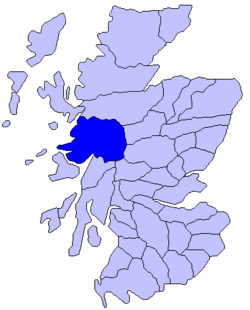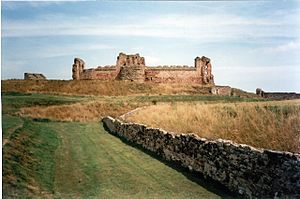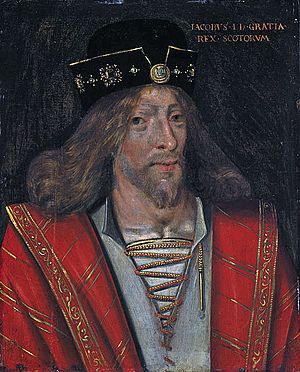Battle of Lochaber facts for kids
Quick facts for kids Battle of Lochaber |
|||||||
|---|---|---|---|---|---|---|---|
| Part of the Scottish clan wars | |||||||
 Historic district of Lochaber |
|||||||
|
|||||||
| Belligerents | |||||||
Clan Donald Clan Cameron Clan Mackintosh |
|||||||
| Commanders and leaders | |||||||
| King James I | Alexander MacDonald Donald Cameron |
||||||
| Strength | |||||||
| Unknown | Unknown | ||||||
| Casualties and losses | |||||||
| Unknown | Unknown | ||||||
The Battle of Lochaber was a fight in 1429 in the Scottish Highlands. It was between the army of Alexander of Islay, Earl of Ross, a powerful leader of Clan Donald, and the army of King James I of Scotland.
Some people call it the Battle of Split Allegiances. This is because some groups, like the Camerons, changed sides during the battle. They either didn't want to fight their King, or different parts of their clan chose different sides.
Contents
Why the Battle Happened
A King Returns
For many years, King James I of Scotland was held prisoner in England. During this time, a powerful Scottish noble named Robert Stewart, Duke of Albany ruled Scotland in his place. He was like a temporary king, called a "regent."
When King James finally returned to Scotland in 1424, he wanted to take full control. He quickly showed everyone who was boss. He even arrested many of Albany's family members.
The Fight for Ross
The Lords of the Isles were very powerful leaders in western Scotland. They often tried to expand their lands. One important area they wanted was the Earldom of Ross. This was a large territory in northern Scotland.
Alexander MacDonald, the Lord of the Isles, believed he should be the Earl of Ross. His mother, Mariota, had been the Countess of Ross. When she died in 1429, Alexander claimed the title.
However, King James I also had a claim to Ross. He wanted to make sure he controlled all of Scotland. In 1428, King James called a meeting in Inverness Castle. He arrested Alexander and many other northern leaders. Alexander was later released, but the tension between him and the King remained.
The March to Battle
After being arrested, Alexander MacDonald was very angry. He decided to show his strength. He gathered a large army, possibly as many as 10,000 men. This army included clans like the Camerons and the Chattan Confederation (Clan Mackintosh). These clans had often fought each other, but they joined forces against the King.
Alexander marched his army to Inverness. He burned parts of the town and tried to capture the castle. But he couldn't take the castle. His army was too big to stay in one place for long without enough supplies. So, he started heading back west towards his home.
King James I quickly gathered his own army and went after Alexander.
The Battle of Lochaber
The King's army surprised Alexander's forces. The battle happened on a marshy field in Lochaber, near where Fort William is today. The exact date is not fully known, but it was likely around June 23 or 26, 1429.
Changing Sides
During the battle, something surprising happened. The Camerons, led by Donald Dubh, switched sides! They decided to support the King instead of Alexander, their powerful leader. Some say only a part of the Cameron clan changed sides, which is why they call it the "Battle of Split Allegiances." The Mackintoshes also decided to join the King.
It's not clear if King James promised them rewards for switching sides. But soon after, the King gave the Mackintoshes some lands in Lochaber.
With so many fighters leaving his side, Alexander MacDonald's army was much weaker. He was either defeated in battle or fled without fighting.
What Happened Next
Alexander escaped to the islands. At first, King James refused to make peace with him. So, Alexander went secretly to Edinburgh. He showed great humility by appearing in just his shirt and underwear. He gave his sword to King James at Holyrood Abbey.

The Queen, Joan Beaufort, was impressed by Alexander's actions. She asked the King to spare his life. So, Alexander was imprisoned again, this time in Tantallon Castle.
Alexander was released in November 1431. After this, King James accepted Alexander as the Earl of Ross. He even allowed him to control Inverness.
The Battle of Lochaber was an important event for the Clan Cameron. The part of the clan that switched sides, the MacMartins, were later punished by other Camerons. The MacMartin chiefs were forced to leave their homes. This helped the Lochiel part of the clan become the main leaders.


